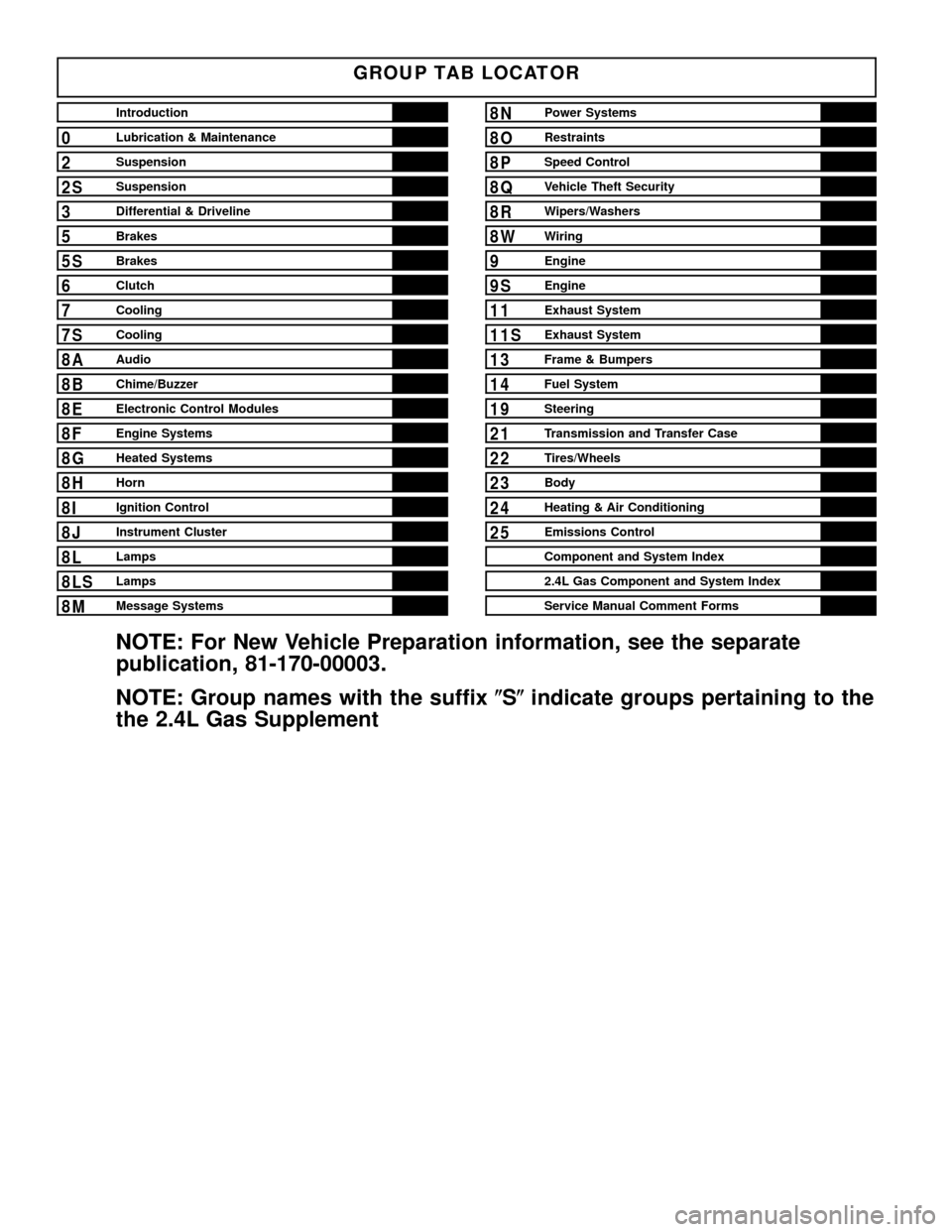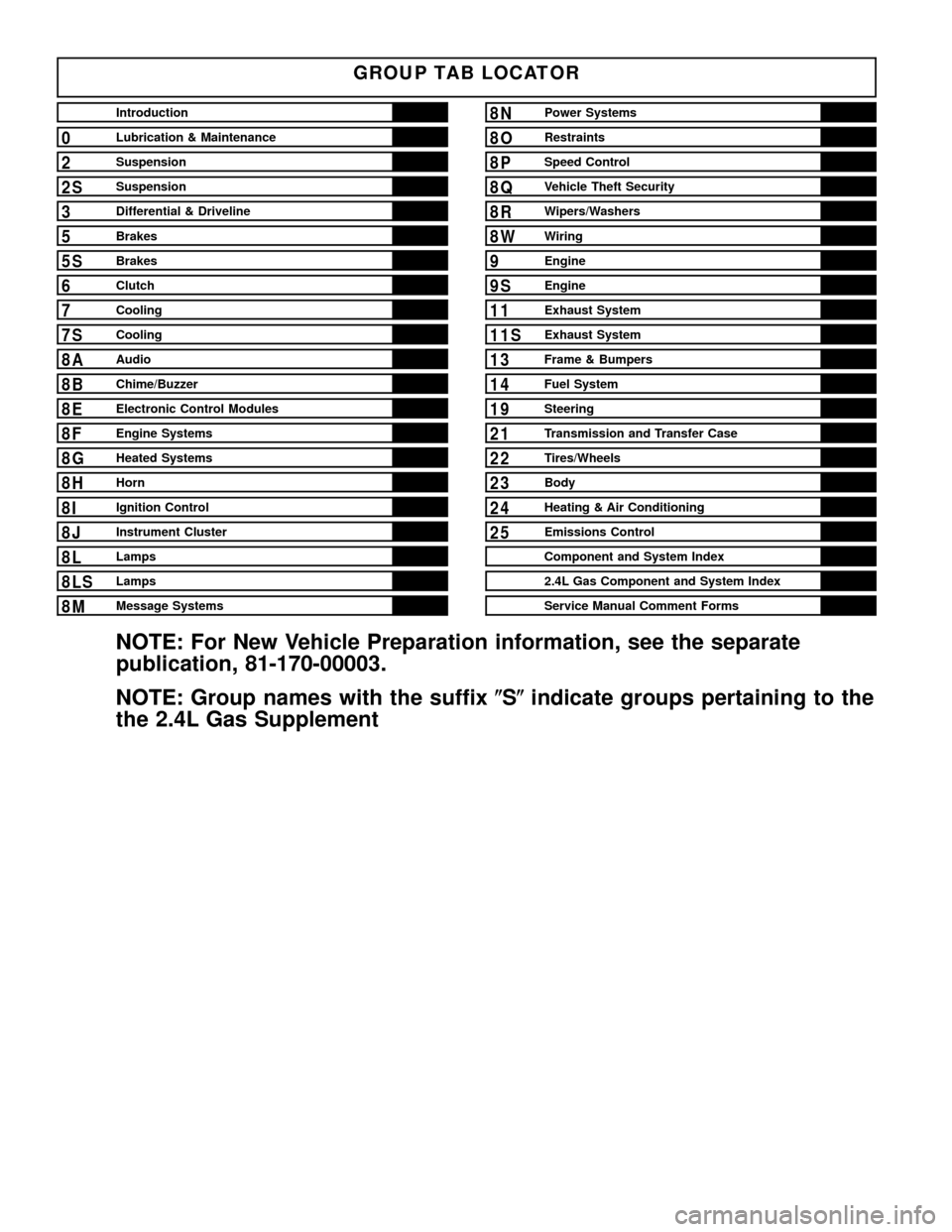Heated systems JEEP LIBERTY 2002 KJ / 1.G Workshop Manual
[x] Cancel search | Manufacturer: JEEP, Model Year: 2002, Model line: LIBERTY, Model: JEEP LIBERTY 2002 KJ / 1.GPages: 1803, PDF Size: 62.3 MB
Page 3 of 1803

GROUP TAB LOCATOR
Introduction
0Lubrication & Maintenance
2Suspension
2SSuspension
3Differential & Driveline
5Brakes
5SBrakes
6Clutch
7Cooling
7SCooling
8AAudio
8BChime/Buzzer
8EElectronic Control Modules
8FEngine Systems
8GHeated Systems
8HHorn
8IIgnition Control
8JInstrument Cluster
8LLamps
8LSLamps
8MMessage Systems
8NPower Systems
8ORestraints
8PSpeed Control
8QVehicle Theft Security
8RWipers/Washers
8WWiring
9Engine
9SEngine
11Exhaust System
11SExhaust System
13Frame & Bumpers
14Fuel System
19Steering
21Transmission and Transfer Case
22Tires/Wheels
23Body
24Heating & Air Conditioning
25Emissions Control
Component and System Index
2.4L Gas Component and System Index
Service Manual Comment Forms
NOTE: For New Vehicle Preparation information, see the separate
publication, 81-170-00003.
NOTE: Group names with the suffix(S(indicate groups pertaining to the
the 2.4L Gas Supplement
Page 321 of 1803

controls the ground for the heated seat switch indi-
cator lamps (LED's).
When a heated seat switch (Driver or Passenger) is
depressed a signal is received by the heated seat
module, the module energizes the proper indicator
LED (Low or High) in the switch by grounding the
indicator lamp circuit to indicate that the heated seat
system is operating. At the same time, the heated
seat module energizes the selected heated seat sensor
circuit and the sensor provides the module with an
input indicating the surface temperature of the
selected seat cushion.
The Low heat set point is about 36É C (96.8É F),
and the High heat set point is about 42É C (107.6É F).
If the seat cushion surface temperature input is
below the temperature set point for the selected tem-
perature setting, the heated seat module energizes
an N-channel Field Effect Transistor (N-FET) within
the module which energizes the heated seat elements
in the selected seat cushion and back. When the sen-
sor input to the module indicates the correct temper-
ature set point has been achieved, the module
de-energizes the N-FET which de-energizes the
heated seat elements. The heated seat module will
continue to cycle the N-FET as needed to maintain
the selected temperature set point.
If the heated seat module detects a heated seat
sensor value input that is out of range or a shorted
or open heated seat element circuit, it will notify the
vehicle operator or the repair technician of this con-
dition by flashing the High and/or Low indicator
lamps in the affected heated seat switch. Refer to
Diagnosis and Testing Heated Seat Systemin
Heated Systems for flashing LED diagnosis and test-
ing procedures. Refer toDiagnosis and Testing
Heated Seat Modulein this section for heated seat
module diagnosis and testing procedures. Also refer
to the Body Diagnostic Manual for additional diagno-
sis and testing procedures.
DIAGNOSIS AND TESTING - HEATED SEAT
MODULE
If a heated seat fails to heat and one or both of the
indicator lamps on a heated seat switch flash, refer
toHeated Seat System Diagnosis and Testingin
Heated Systems for flashing LED failure identifica-
tion. Refer toWiring Diagramsin for complete
heated seat system wiring diagrams.
(1) Remove the heated seat module from its
mounting location (Refer to 8 - ELECTRICAL/ELEC-
TRONIC CONTROL MODULES/MEMORY HEATED
SEAT/MIRROR MODULE - REMOVAL).NOTE: ANY RESISTANCE VALUES (OHMSV) GIVEN
IN THE FOLLOWING TEXT ARE SUPPLIED USING
THE AUTOMATIC RANGE GENERATED BY A
FLUKETAUTOMOTIVE METER. IF ANOTHER TYPE
OF MEASURING DEVICE IS USED THE VALUES
GENERATED MAY NOT BE THE SAME AS THE
RESULTS SHOWN HERE, OR MAY HAVE TO BE
CONVERTED TO THE RANGE USED HERE.
RIGHT SEAT HEATER INOPERATIVE
(1) If a heated seat heats but one or both indicator
lamps (LED's) on the heated seat switch fail to illu-
minate, check the driver circuit with the inoperative
LED for a short to ground. If OK, replace the heated
seat switch. If NOT OK repair the short to ground as
required and than replace the heated seat switch.
NOTE: IF THE RIGHT SEAT CUSHION IS ALREADY
WARM THE FOLLOWING STEP WILL NOT PROVE
CONCLUSIVE.
(2) Back-probe the heated seat module wire har-
ness connector (Fig. 15), do not disconnect. Check
cavity #3 for battery voltage when the right heated
seat switch is turned ªONº, voltage should be
present, If OK go to Step 3 If NOT OK, test the right
heated seat switch (Refer to 8 - ELECTRICAL/
HEATED SEATS/PASSENGER HEATED SEAT
SWITCH - DIAGNOSIS AND TESTING). If the
switch tests OK, check for continuity between the
switch and control module on the MUX circuit, If OK
replace the heated seat control module. If NOT OK,
repair the open or shorted MUX circuit as required.
Fig. 15 Heated Seat Module Electrical Connector
8E - 22 ELECTRONIC CONTROL MODULESKJ
HEATED SEAT MODULE (Continued)
Page 368 of 1803

HEATED SYSTEMS
TABLE OF CONTENTS
page page
HEATED MIRRORS......................... 1
WINDOW DEFOGGER....................... 3HEATED SEAT SYSTEM.................... 10
HEATED MIRRORS
TABLE OF CONTENTS
page page
HEATED MIRRORS
DESCRIPTION..........................1
OPERATION............................1DIAGNOSIS AND TESTING - HEATED
MIRRORS............................1
HEATED MIRRORS
DESCRIPTION
Vehicles equipped with the optional heated mirror
package have an electric heating grid located behind
the mirror glass of each outside rear view mirror.
The heated mirrors are controlled by the rear win-
dow defogger switch. Electrical current is directed to
the heating grid inside the mirror only when the rear
window defogger switch is in the On position.
If the outside mirror heating grids and the rear
window heating grid are all inoperative, (Refer to 8 -
ELECTRICAL/HEATED GLASS - DIAGNOSIS AND
TESTING). If the outside mirror heating grids are
inoperative, but the rear window heating grid is
operating as designed, (Refer to 8 - ELECTRICAL/
HEATED MIRRORS - DIAGNOSIS AND TESTING).
The heating grid behind each outside mirror glass
cannot be repaired and, if faulty or damaged, the
entire power mirror unit must be replaced(Refer to 8
- ELECTRICAL/POWER MIRRORS/SIDEVIEW MIR-
ROR - REMOVAL) and (Refer to 8 - ELECTRICAL/
POWER MIRRORS/SIDEVIEW MIRROR -
INSTALLATION).
OPERATION
The heated mirror is controlled by the rear window
defogger switch. The only time that the heated mir-
ror is on is when the rear window defogger is on. The
mirror should become warm to the touch.
DIAGNOSIS AND TESTING - HEATED MIRRORS
For circuit descriptions and diagrams (Refer to
Appropriate Wiring Information).
(1) Check the fuse in the junction block. If OK, go
to Step 2. If not OK, repair the shorted circuit or
component as required and replace the faulty fuse.
(2) Turn the ignition switch to the On position.
Check for battery voltage at the fuse in the junction
block. If OK, go to Step 3. If not OK, repair the open
circuit to the ignition switch as required.
(3) Disconnect and isolate the battery negative
cable. Remove the front door trim panel on the side
of the vehicle with the inoperative mirror heating
grid. Unplug the wire harness connector at the mir-
ror. Check for continuity between the ground circuit
cavity in the body half of the power mirror wire har-
ness connector and a good ground. If OK, go to Step
4. If not OK, repair the open circuit to ground as
required.
(4) Connect the battery negative cable. Turn the
ignition switch to the On position. Turn on the rear
window defogger system. Check for battery voltage at
the rear window defogger relay output circuit cavity
in the body half of the power mirror wire harness
connector. If OK, go to Step 5. If not OK, repair the
open circuit to the rear window defogger relay as
required.
KJHEATED SYSTEMS 8G - 1
Page 438 of 1803

The turn signal indicators are connected in parallel
with the other turn signal circuits. This arrangement
allows the turn signal indicators to remain func-
tional, regardless of the condition of the other cir-
cuits in the turn signal and hazard warning systems.
The combination flasher outputs of the hazard switch
to the instrument cluster turn signal indicator inputs
can be diagnosed using conventional diagnostic tools
and methods. (Refer to 8 - ELECTRICAL/LAMPS/
LIGHTING - EXTERIOR/HAZARD SWITCH -
DESCRIPTION) for more information on the combi-
nation flasher and hazard switch operation.
WAIT-TO-START INDICATOR
DESCRIPTION
A wait-to-start indicator is only found in the
instrument clusters of vehicles equipped with an
optional diesel engine. The wait-to-start indicator is
located above the fuel gauge and to the left of the
tachometer in the instrument cluster. The wait-to-
start indicator consists of a stencil-like cutout of the
International Control and Display Symbol icon for
ªDiesel Preheatº in the opaque layer of the instru-
ment cluster overlay. The dark outer layer of the
overlay prevents the indicator from being clearly vis-
ible when it is not illuminated. An amber Light
Emitting Diode (LED) behind the cutout in the
opaque layer of the overlay causes the icon to appear
in amber through the translucent outer layer of the
overlay when it is illuminated from behind by the
LED, which is soldered onto the instrument cluster
electronic circuit board. The wait-to-start indicator is
serviced as a unit with the instrument cluster.
OPERATION
The wait-to-start indicator gives an indication to
the vehicle operator when the diesel engine glow
plugs are energized in their pre-heat operating mode.
This indicator is controlled by a transistor on the
instrument cluster electronic circuit board based
upon the cluster programming and electronic mes-
sages received by the cluster from the Powertrain
Control Module (PCM) over the Programmable Com-
munications Interface (PCI) data bus. The wait-to-
start indicator Light Emitting Diode (LED) is
completely controlled by the instrument cluster logic
circuit, and that logic will only allow this indicator to
operate when the instrument cluster receives a bat-
tery current input on the fused ignition switch out-
put (run-start) circuit. Therefore, the LED will
always be off when the ignition switch is in any posi-
tion except On or Start. The LED only illuminates
when it is provided a path to ground by the instru-
ment cluster transistor. The instrument cluster willturn on the wait-to-start indicator for the following
reasons:
²Wait-To-Start Lamp-On Message- Each time
the cluster receives a wait-to-start lamp-on message
from the PCM indicating the glow plugs are heating
and the driver must wait to start the engine, the
wait-to-start indicator will be illuminated. The indi-
cator remains illuminated until the cluster receives a
wait-to-start lamp-off message, or until the ignition
switch is turned to the Off position, whichever occurs
first.
²Actuator Test- Each time the cluster is put
through the actuator test, the wait-to-start indicator
will be turned on, then off again during the bulb
check portion of the test to confirm the functionality
of the LED and the cluster control circuitry.
The PCM continually monitors the ambient tem-
perature and the glow plug pre-heater circuits to
determine how long the glow plugs must be heated in
the pre-heat operating mode. The PCM then sends
the proper wait-to-start lamp-on and lamp-off mes-
sages to the instrument cluster. For further diagnosis
of the wait-to-start indicator or the instrument clus-
ter circuitry that controls the indicator, (Refer to 8 -
ELECTRICAL/INSTRUMENT CLUSTER - DIAGNO-
SIS AND TESTING). For proper diagnosis of the
glow plug pre-heater control circuits, the PCM, the
PCI data bus, or the electronic message inputs to the
instrument cluster that control the wait-to-start indi-
cator, a DRBIIItscan tool is required. Refer to the
appropriate diagnostic information.
WASHER FLUID INDICATOR
DESCRIPTION
A washer fluid indicator is standard equipment on
all instrument clusters. The washer fluid indicator
consists of the text ªlowashº, which appears in place
of the odometer/trip odometer information in the Vac-
uum-Fluorescent Display (VFD) of the instrument
cluster. The VFD is part of the cluster electronic cir-
cuit board, and is visible through a cutout located
near the lower edge of the speedometer dial face in
the instrument cluster. The dark outer layer of the
overlay prevents the VFD from being clearly visible
when it is not illuminated. The text message
ªlowashº appears in the same blue-green color and at
the same lighting level as the odometer/trip odometer
information through the translucent outer layer of
the overlay when it is illuminated by the instrument
cluster electronic circuit board. The washer fluid
indicator is serviced as a unit with the instrument
cluster.
KJINSTRUMENT CLUSTER 8J - 35
TURN SIGNAL INDICATOR (Continued)
Page 598 of 1803

The CMTC may also be integrated with the Uni-
versal Transmitter. If so, your CMTC module will
have three buttons centered together between the
outer four buttons. Below the three buttons are cor-
responding dots to indicate which button you are
using.
The Compass Mini-Trip Computer includes the fol-
lowing display options:
²Compass and thermometer- provides the out-
side temperature and one of eight compass readings
to indicate the direction the vehicle is facing.
²Average fuel economy- shows the average
fuel economy since the last trip computer reset.
²Distance to empty- shows the estimated dis-
tance that can be travelled with the fuel remaining
in the fuel tank. This estimated distance is computed
using the average miles-per-gallon from the last 30
gallons of fuel used.
²Instant fuel economy- shows the present fuel
economy based upon the current vehicle distance and
fuel used information.
²Trip odometer- shows the distance travelled
since the last trip computer reset.
²Elapsed time- shows the accumulated igni-
tion-on time since the last trip computer reset.
²Blank screen- the CMTC compass/thermome-
ter/trip computer VFD is turned off.
If the vehicle is equipped with the optional Univer-
sal Transmitter transceiver, the CMTC will also dis-
play messages and an icon indicating when the
Universal Transmitter is being trained, which of the
three transmitter buttons is transmitting, and when
the transceiver is cleared.
Data input for all CMTC functions, including VFD
dimming level, is received through PCI data bus
messages. The CMTC module uses its internal pro-
gramming and all of its data inputs to calculate and
display the requested data. If the data displayed is
incorrect, perform the self-diagnostic tests as
described in this group. If these tests prove inconclu-
sive, the use of a DRBIIItscan tool and the proper
Diagnostic Procedures manual are recommended for
further testing of the CMTC module and the PCI
data bus.
The CMTC module cannot be repaired, and is
available for service only as a unit. This unit
includes the push button switches and the plastic
module and display lens. If any of these components
is faulty or damaged, the complete CMTC module
must be replaced. The incandescent bulbs used for
CMTC push button back-lighting are available for
service replacement.
DESCRIPTION - COMPASS
While in the compass/thermometer mode, the com-
pass will display the direction in which the vehicle ispointed using the eight major compass headings
(Examples: north is N, northeast is NE). The self-cal-
ibrating compass unit requires no adjusting in nor-
mal use. The only calibration that may prove
necessary is to drive the vehicle in three complete
circles at 5 to 8 kilometers-per-hour (3 to 5 miles-per-
hour), on level ground, in not less than forty-eight
seconds. This will reorient the compass unit to its
vehicle.
The compass unit also will compensate for magne-
tism the body of the vehicle may acquire during nor-
mal use. However, avoid placing anything magnetic
directly on the roof of the vehicle. Magnetic mounts
for an antenna, a repair order hat, or a funeral pro-
cession flag can exceed the compensating ability of
the compass unit if placed on the roof panel. Mag-
netic bit drivers used on the fasteners that hold the
overhead console assembly to the roof header can
also affect compass operation. If the vehicle roof
should become magnetized, the demagnetizing and
calibration procedures found in this group may be
required to restore proper compass operation.
DESCRIPTION - THERMOMETER
The thermometer displays the outside ambient
temperature in whole degrees. The temperature dis-
play can be toggled from Fahrenheit to Celsius by
using the U.S./Metric button. The displayed temper-
ature is not an instant reading of conditions, but an
average temperature. It may take the thermometer
display several minutes to respond to a major tem-
perature change, such as driving out of a heated
garage into winter temperatures.
When the ignition switch is turned to the Off posi-
tion, the last displayed temperature reading stays in
the Body Control Module (BCM) unit memory. When
the ignition switch is turned to the On position
again, the CMTC will display the memory tempera-
ture for one minute; then update the display to the
current average temperature reading within five
minutes.
The thermometer function is supported by an
ambient temperature sensor. The sensor is mounted
outside the passenger compartment near the front
and center of the vehicle, and is hard wired to the
Body Control Module (BCM). The BCM sends tem-
perature status messages to the CMTC module over
the PCI data bus network. The ambient temperature
sensor is available as a separate service item, refer to
additional information later in this section.
OPERATION
The compass mini-trip computer operates when the
ignition is in the ON position. The VFD will display
the last display before ignition was turned OFF. The
four outer buttons operate:
KJMESSAGE SYSTEMS 8M - 5
COMPASS/MINI-TRIP COMPUTER (Continued)
Page 1654 of 1803

DESCRIPTION - REFRIGERANT SYSTEM
SERVICE PORT
The two refrigerant system service ports are used
to charge, recover/recycle, evacuate, and test the air
conditioning refrigerant system. Unique service port
coupler sizes are used on the R-134a system, to
ensure that the refrigerant system is not accidentally
contaminated by the use of the wrong refrigerant
(R-12), or refrigerant system service equipment.
OPERATION
OPERATION - HEATER AND AIR CONDITIONER
The heater and optional air conditioner are blend-
air type systems. In a blend-air system, a blend door
controls the amount of unconditioned air (or cooled
air from the evaporator on models with air condition-
ing) that is allowed to flow through, or around, the
heater core. A temperature control knob on the A/C
Heater control panel determines the discharge air
temperature by controlling an electric actuator,
which moves the blend door. This allows an almost
immediate control of the output air temperature of
the system.
The mode control knob on the heater-only or A/C
Heater control panel is used to direct the conditioned
air to the selected system outlets. Both mode control
switches use engine vacuum to control the mode
doors, which are operated by vacuum actuators.
On all vehicles, the outside air intake can be shut
off by selecting the Recirculation Mode with the
mode control knob. This will operate a vacuum actu-
ated recirculation door that closes off the outside
fresh air intake and recirculates the air that is
already inside the vehicle.
The optional air conditioner for all models is
designed for the use of non-CFC, R-134a refrigerant.
The air conditioning system has an evaporator to cool
and dehumidify the incoming air prior to blending it
with the heated air. This air conditioning system
uses a fixed orifice tube in the liquid line near the
condenser outlet tube to meter refrigerant flow to the
evaporator coil. To maintain minimum evaporator
temperature and prevent evaporator freezing, the
A/C low pressure switch on the accumulator cycles
the compressor clutch.
OPERATION - REFRIGERANT SYSTEM SERVICE
PORT
The high pressure service port is located on the
refrigerant line, near the discharge port of the com-
pressor. The low pressure service port is located on
the liquid line at the side of the engine compartment,
near the condensor.Each of the service ports has a threaded plastic
protective cap installed over it from the factory. After
servicing the refrigerant system, always reinstall
both of the service port caps.
DIAGNOSIS AND TESTING
DIAGNOSIS AND TESTING - A/C
PERFORMANCE
The air conditioning system is designed to provide
the passenger compartment with low temperature
and low humidity air. The evaporator, located in the
HVAC housing on the dash panel below the instru-
ment panel, is cooled to temperatures near the freez-
ing point. As warm damp air passes through the
cooled evaporator, the air transfers its heat to the
refrigerant in the evaporator and the moisture in the
air condenses on the evaporator fins. During periods
of high heat and humidity, an air conditioning sys-
tem will be more effective in the Recirculation Mode.
With the system in the Recirculation Mode, only air
from the passenger compartment passes through the
evaporator. As the passenger compartment air dehu-
midifies, the air conditioning system performance
levels improve.
Humidity has an important bearing on the temper-
ature of the air delivered to the interior of the vehi-
cle. It is important to understand the effect that
humidity has on the performance of the air condition-
ing system. When humidity is high, the evaporator
has to perform a double duty. It must lower the air
temperature, and it must lower the temperature of
the moisture in the air that condenses on the evapo-
rator fins. Condensing the moisture in the air trans-
fers heat energy into the evaporator fins and tubing.
This reduces the amount of heat the evaporator can
absorb from the air. High humidity greatly reduces
the ability of the evaporator to lower the temperature
of the air.
However, evaporator capacity used to reduce the
amount of moisture in the air is not wasted. Remov-
ing some of the moisture out of the air entering the
vehicle adds to the comfort of the passengers.
Although, an owner may expect too much from the
air conditioning system on humid days. A perfor-
mance test is the best way to determine whether the
system is performing up to standard. This test also
provides valuable clues as to the possible cause of
trouble with the air conditioning system.
Before proceeding, (Refer to 24 - HEATING & AIR
CONDITIONING/PLUMBING - WARNING) and
(Refer to 24 - HEATING & AIR CONDITIONING/
PLUMBING - CAUTION). The air temperature in
the test room and in the vehicle must be a minimum
of 21É C (70É F) for this test.
24 - 2 HEATING & AIR CONDITIONINGKJ
HEATING & AIR CONDITIONING (Continued)
Page 1747 of 1803

DIFFERENTIAL - TRAC-LOK - CLEANING . . 3-109,
3-77
DIFFERENTIAL - TRAC-LOK -
DISASSEMBLY...................3-107,3-75
DIFFERENTIAL - TRAC-LOK -
INSPECTION....................3-109,3-77
DIFFERENTIAL CASE BEARINGS -
INSTALLATION...............3-110,3-44,3-79
DIFFERENTIAL CASE BEARINGS -
REMOVAL..................3-110,3-43,3-79
DIMENSIONS - SPECIFICATIONS, FRAME . . . 13-3
DIMENSIONS - SPECIFICATIONS,
OPENING..........................23-111
DIODE - INSTALLATION............8W-01-14
DIODE - REMOVAL................8W-01-14
DIODE REPLACEMENT - STANDARD
PROCEDURE.........................24-9
DISASSEMBLY - POWER DISTRIBUTION
CENTER DISASSEMBLY.............8W-97-7
DISASSEMBLY, 4C RETAINER/BULKHEAD . 21-122
DISASSEMBLY, DIAGNOSIS AND
TESTING...........................21-83
DISASSEMBLY, DIFFERENTIAL......3-105,3-41
DISASSEMBLY, DIFFERENTIAL -
TRAC-LOK......................3-107,3-75
DISASSEMBLY, DISASSEMBLY - POWER
DISTRIBUTION CENTER.............8W-97-7
DISASSEMBLY, DISC BRAKE CALIPERS....5-14
DISASSEMBLY, HVAC HOUSING.........24-34
DISASSEMBLY, INPUT CLUTCH
ASSEMBLY.........................21-135
DISASSEMBLY, INSTRUMENT CLUSTER....8J-9
DISASSEMBLY, LOW/REVERSE CLUTCH . . 21-145
DISASSEMBLY, MANUAL - NV1500........21-4
DISASSEMBLY, MANUAL - NV3550.......21-35
DISASSEMBLY, OIL PUMP...............9-65
DISASSEMBLY, OIL PUMP.............21-149
DISASSEMBLY, PLANETARY GEARTRAIN . 21-159
DISASSEMBLY, SINGLE CARDAN
UNIVERSAL JOINTS....................3-8
DISASSEMBLY, TRANSFER CASE -
NV231............................21-182
DISASSEMBLY, TRANSFER CASE -
NV242............................21-218
DISASSEMBLY, VALVE BODY...........21-173
DISASSEMBLY, WHEEL CYLINDERS.......5-28
DISC - INSTALLATION, CLUTCH...........6-6
DISC - REMOVAL, CLUTCH...............6-6
DISC BRAKE CALIPER ADAPTER -
INSTALLATION........................5-18
DISC BRAKE CALIPER ADAPTER -
REMOVAL...........................5-18
DISC BRAKE CALIPERS - ASSEMBLY......5-16
DISC BRAKE CALIPERS - CLEANING......5-16
DISC BRAKE CALIPERS - DESCRIPTION....5-13
DISC BRAKE CALIPERS - DISASSEMBLY . . . 5-14
DISC BRAKE CALIPERS - INSPECTION.....5-16
DISC BRAKE CALIPERS - INSTALLATION . . . 5-17
DISC BRAKE CALIPERS - OPERATION.....5-14
DISC BRAKE CALIPERS - REMOVAL.......5-14
DISC BRAKE ROTOR - DIAGNOSIS AND
TESTING............................5-18
DISC BRAKE ROTOR - STANDARD
PROCEDURE.........................5-19
DISCHARGE (ESD) SENSITIVE DEVICES -
STANDARD PROCEDURE,
ELECTROSTATIC...................8W-01-8
DISCHARGE LINE - INSTALLATION, A/C . . . 24-47
DISCHARGE LINE - REMOVAL, A/C.......24-46
DISPLAY TEST MODE - DESCRIPTION,
STATE ..............................25-2
DISTRIBUTION - DESCRIPTION, POWER . 8W-97-1
DISTRIBUTION - OPERATION, POWER . . 8W-97-1
DISTRIBUTION CENTER - DESCRIPTION,
POWER..........................8W-97-6
DISTRIBUTION CENTER - OPERATION,
POWER..........................8W-97-7
DISTRIBUTION CENTER - REMOVAL,
POWER..........................8W-97-7
DISTRIBUTION CENTER ASSEMBLY,
ASSEMBLY - POWER
..............8W-97-10
DISTRIBUTION CENTER DISASSEMBLY,
DISASSEMBLY - POWER
............8W-97-7
DISTRIBUTION SYSTEMS, SPECIAL
TOOLS - POWER
...................8W-97-2
DOO - INSTALLATION, FLOOR -
DEFROST
...........................24-37
DOOR - INSTALLATION
.........23-122,23-129DOOR - INSTALLATION, BLEND.........24-35
DOOR - INSTALLATION, PANEL..........24-36
DOOR - INSTALLATION, PASSENGER
AIRBAG............................8O-30
DOOR - INSTALLATION, RECIRC.........24-37
DOOR - REMOVAL.............23-122,23-129
DOOR - REMOVAL, BLEND.............24-35
DOOR - REMOVAL, DEFROST...........24-35
DOOR - REMOVAL, FLOOR - DEFROST....24-36
DOOR - REMOVAL, PASSENGER AIRBAG . . 8O-29
DOOR - REMOVAL, RECIRC............24-37
DOOR ACTUATOR - INSTALLATION,
BLEND.............................24-20
DOOR ACTUATOR - INSTALLATION,
FLOOR - DEFROST...................24-25
DOOR ACTUATOR - INSTALLATION,
PANEL.............................24-25
DOOR ACTUATOR - INSTALLATION,
RECIRCULATION.....................24-26
DOOR ACTUATOR - REMOVAL, BLEND....24-20
DOOR ACTUATOR - REMOVAL, FLOOR -
DEFROST...........................24-24
DOOR ACTUATOR - REMOVAL, PANEL....24-24
DOOR ACTUATOR - REMOVAL,
RECIRCULATION.....................24-26
DOOR AJAR INDICATOR - DESCRIPTION . . 8J-17
DOOR AJAR INDICATOR - OPERATION....8J-17
DOOR AJAR SWITCH - DESCRIPTION....8L-77
DOOR AJAR SWITCH - OPERATION........8L-77
DOOR CYLINDER LOCK SWITCH -
DESCRIPTION........................8Q-9
DOOR CYLINDER LOCK SWITCH -
DIAGNOSIS AND TESTING.............8Q-10
DOOR CYLINDER LOCK SWITCH -
INSTALLATION......................8Q-10
DOOR CYLINDER LOCK SWITCH -
OPERATION.........................8Q-10
DOOR CYLINDER LOCK SWITCH -
REMOVAL..........................8Q-10
DOOR GLASS - INSTALLATION . . 23-122,23-129,
23-172
DOOR GLASS - REMOVAL......23-122,23-129,
23-172
DOOR LOCK / UNLOCK SWITCH -
INSTALLATION.......................8N-5
DOOR LOCK / UNLOCK SWITCH -
REMOVAL...........................8N-4
DOOR LOCK MOTOR - DESCRIPTION......8N-5
DOOR LOCK MOTOR - DIAGNOSIS AND
TESTING............................8N-5
DOOR LOCK MOTOR - OPERATION.......8N-5
DOOR LOCK RELAY - DESCRIPTION......8N-6
DOOR LOCK RELAY - DIAGNOSIS AND
TESTING............................8N-6
DOOR LOCK RELAY - INSTALLATION......8N-7
DOOR LOCK RELAY - OPERATION........8N-6
DOOR LOCK RELAY - REMOVAL.........8N-6
DOOR LOCK/UNLOCK SWITCH -
DIAGNOSIS AND TESTING..............8N-4
DOOR LOWER WEATHERSTRIP -
INSTALLATION......................23-186
DOOR LOWER WEATHERSTRIP -
REMOVAL.........................23-186
DOOR OUTER BELT MOLDING -
INSTALLATION, FRONT...............23-186
DOOR OUTER BELT MOLDING -
INSTALLATION, REAR................23-186
DOOR OUTER BELT MOLDING -
REMOVAL, FRONT...................23-186
DOOR OUTER BELT MOLDING -
REMOVAL, REAR....................23-186
DOOR PRIMARY WEATHERSTRIP -
INSTALLATION......................23-185
DOOR PRIMARY WEATHERSTRIP -
REMOVAL.........................23-185
DOOR SCUFF PLATE - INSTALLATION,
REAR.............................23-160
DOOR SCUFF PLATE - REMOVAL, REAR . . 23-160
DOOR SILL SCUFF PLATE -
INSTALLATION......................23-157
DOOR SILL SCUFF PLATE - REMOVAL
. . . 23-157
DOOR/HOUSING - INSTALLATION, FUEL
FILL
..............................23-141
DOOR/HOUSING - REMOVAL, FUEL FILL
. 23-141
DOUBLE INVERTED FLARING -
STANDARD PROCEDURE
.................5-8
DRAIN AND FILL - STANDARD
PROCEDURE, FLUID
...........21-208,21-246DRAIN TUBE - INSTALLATION..........23-181
DRAIN TUBE - REMOVAL.............23-180
DRAINAGE AND WIND NOISE
DIAGNOSIS, DIAGNOSIS AND TESTING
- WATER ..........................23-176
DRAINING COOLING SYSTEM 3.7L
ENGINE - STANDARD PROCEDURE........7-12
DRAW TEST - STANDARD PROCEDURE,
IGNITION-OFF.......................8F-14
DRIVE - DIAGNOSIS AND TESTING,
VISCOUS FAN........................7-28
DRIVE BELT - DIAGNOSIS AND TESTING,
SERPENTINE.........................7-15
DRIVE MOTOR - INSTALLATION........23-182
DRIVE MOTOR - REMOVAL............23-182
DRIVER AIRBAG - DESCRIPTION........8O-17
DRIVER AIRBAG - INSTALLATION.......8O-20
DRIVER AIRBAG - OPERATION..........8O-18
DRIVER AIRBAG - REMOVAL...........8O-19
DRIVER SEAT HEATER SWITCH -
DESCRIPTION.......................8G-11
DRIVER SEAT HEATER SWITCH -
INSTALLATION......................8G-13
DRIVER SEAT HEATER SWITCH -
OPERATION.........................8G-12
DRIVER SEAT HEATER SWITCH -
REMOVAL..........................8G-13
DRIVER SIDE BEZELS - INSTALLATION,
INSTRUMENT PANEL.................23-154
DRIVER SIDE BEZELS - REMOVAL,
INSTRUMENT PANEL.................23-153
DROP - STANDARD PROCEDURE,
TESTING FOR A VOLTAGE...........8W-01-10
DRUM - DIAGNOSIS AND TESTING,
BRAKE..............................5-27
DRUM BRAKE - ADJUSTMENT, REAR......5-12
DRUM BRAKE - DESCRIPTION, REAR.....5-10
DRUM BRAKE - OPERATION, REAR.......5-11
DRUM BRAKE SHOES - INSTALLATION....5-11
DRUM BRAKE SHOES - REMOVAL........5-11
DRUM MACHINING - STANDARD
PROCEDURES, BRAKE.................5-27
DUCT - INSTALLATION, DEFROST/
DEMISTER..........................24-32
DUCT - INSTALLATION, FLOOR..........24-32
DUCT - INSTALLATION, FLOOR CONSOLE . 24-31
DUCT - REMOVAL, FLOOR.............24-32
DUCT - REMOVAL, FLOOR CONSOLE.....24-31
DUCT/DEMISTER ADAPTOR - REMOVAL,
DEFROST...........................24-32
EFFECTS OF INCORRECT FLUID LEVEL -
DIAGNOSIS AND TESTING............21-125
ELECTRIC - DESCRIPTION, RADIATOR
FAN ................................7-26
ELECTRIC - INSTALLATION, RADIATOR
FAN ................................7-27
ELECTRIC - INSTALLATION, WINDOW
REGULATOR.................23-126,23-134
ELECTRIC - OPERATION, RADIATOR FAN . . . 7-26
ELECTRIC - REMOVAL, RADIATOR FAN....7-26
ELECTRIC - REMOVAL, WINDOW
REGULATOR.................23-126,23-134
ELECTRICAL - DESCRIPTION............5-34
ELECTRICAL - OPERATION..............5-34
ELECTRICAL TESTER - STANDARD
PROCEDURE, USING MIDTRONICS.......8F-15
ELECTROSTATIC DISCHARGE (ESD)
SENSITIVE DEVICES - STANDARD
PROCEDURE......................8W-01-8
ELEMENT - DESCRIPTION, HEATED SEAT . 8G-13
ELEMENT - DIAGNOSIS AND TESTING,
HEATED SEAT .......................8G-13
ELEMENT - OPERATION, HEATED SEAT . . . 8G-13
EMISSION CONTROL INFORMATION
(VECI) LABEL - DESCRIPTION,
VEHICLE..........................Intro.-8
EMISSION CONTROL SYSTEM -
DESCRIPTION........................25-1
END - INSTALLATION, TIE ROD.........19-16
END - REMOVAL, TIE ROD.............19-16
END CAP - INSTALLATION, INSTRUMENT
PANEL
............................23-153
END CAP - REMOVAL, INSTRUMENT
PANEL
............................23-153
END REMOVAL TOOL, SPECIAL TOOLS -
OUTER TIE ROD
.....................19-15
ENGINE - 3.7L - DESCRIPTION
............9-3
ENGINE - DESCRIPTION, 3.7L
............7-21
8 INDEXKJ
Description Group-Page Description Group-Page Description Group-Page
Page 1755 of 1803

LOW PRESSURE SWITCH - OPERATION,
A/C................................24-18
LOW PRESSURE SWITCH - REMOVAL,
A/C................................24-19
LOWER BALL JOINT - DIAGNOSIS AND
TESTING............................2-10
LOWER CONTROL ARM - DESCRIPTION . . . 2-21
LOWER CONTROL ARM - INSTALLATION . . 2-10,
2-21
LOWER CONTROL ARM - OPERATION.....2-21
LOWER CONTROL ARM - REMOVAL . . 2-10,2-21
LOWER TRIM - INSTALLATION,
B-PILLAR..........................23-157
LOWER TRIM - REMOVAL, B-PILLAR....23-157
LOWER WEATHERSTRIP -
INSTALLATION, DOOR................23-186
LOWER WEATHERSTRIP - REMOVAL,
DOOR............................23-186
LOW/REVERSE CLUTCH - ASSEMBLY....21-146
LOW/REVERSE CLUTCH - CLEANING....21-146
LOW/REVERSE CLUTCH - DISASSEMBLY . 21-145
LOW/REVERSE CLUTCH - INSPECTION . . 21-146
LUBRICATION - DESCRIPTION...........9-57
LUBRICATION - DIAGNOSIS AND
TESTING, ENGINE DIAGNOSIS............9-7
LUBRICATION - OPERATION.............9-58
LUBRICATION - STANDARD PROCEDURE,
BODY...............................23-3
LUGGAGE RACK - INSTALLATION.......23-144
LUGGAGE RACK - REMOVAL............23-144
MACHINING - STANDARD PROCEDURES,
BRAKE DRUM........................5-27
MAIN BEARING, FITTING................9-45
MAINTENANCE SCHEDULES -
DESCRIPTION.........................0-4
MALFUNCTION INDICATOR LAMP (MIL) -
DESCRIPTION.......................8J-24
MALFUNCTION INDICATOR LAMP (MIL) -
OPERATION.........................8J-24
MANAGEMENT VALVE - DESCRIPTION,
FLOW...............................14-6
MANAGEMENT VALVE - INSTALLATION,
FLOW...............................14-7
MANAGEMENT VALVE - OPERATION,
FLOW...............................14-6
MANAGEMENT VALVE - REMOVAL,
FLOW...............................14-6
MANAGER - DESCRIPTION, TASK........25-17
MANAGER - OPERATION, TASK.........25-21
MANIFOLD - DESCRIPTION, EXHAUST.....9-69
MANIFOLD - DESCRIPTION, INTAKE.......9-68
MANIFOLD - INSTALLATION, EXHAUST....9-70
MANIFOLD - INSTALLATION, INTAKE......9-69
MANIFOLD - REMOVAL, EXHAUST........9-69
MANIFOLD - REMOVAL, INTAKE..........9-68
MANIFOLD LEAKS - DIAGNOSIS AND
TESTING, INTAKE.....................9-68
MANUAL - INSTALLATION, WINDOW
REGULATOR............23-126,23-133 21-34
MANUAL - REMOVAL, WINDOW
REGULATOR.................23-126,23-133
MANUAL BLEEDING - STANDARD
PROCEDURE..........................5-6
MANUAL, NV1500....................21-30
MANUAL, NV3550....................21-71
MANUAL SEAT RISER - INSTALLATION . . 23-168
MANUAL SEAT RISER - REMOVAL......23-167
MANUAL TRANSMISSION -
DESCRIPTION.........................0-2
MANUAL TRANSMISSION - DIAGNOSIS
AND TESTING...................21-2,21-33
MAP SENSOR - DESCRIPTION..........14-38
MAP SENSOR - INSTALLATION..........14-40
MAP SENSOR - OPERATION............14-38
MAP SENSOR - REMOVAL.............14-39
MASTER CYLINDER - DESCRIPTION......5-24
MASTER CYLINDER - INSPECTION.........6-9
MASTER CYLINDER - INSTALLATION......5-25
MASTER CYLINDER - OPERATION........5-24
MASTER CYLINDER - REMOVAL
..........5-25
MASTER CYLINDER BLEEDING -
STANDARD PROCEDURE
................5-24
MASTER CYLINDER FLUID LEVEL -
STANDARD PROCEDURES
...............5-26
MASTER CYLINDER/POWER BOOSTER -
DIAGNOSIS AND TESTING
..........5-21,5-24
MATCH MOUNTING - STANDARD
PROCEDURE
.........................22-3MATS - INSTALLATION, CARPETS AND
FLOOR............................23-158
MATS - REMOVAL, CARPETS AND
FLOOR............................23-158
MEASUREMENT - STANDARD
PROCEDURE, HEIGHT...................2-4
MEASURING TIMING CHAIN WEAR,
STANDARD PROCEDURE................9-71
MECHANICAL - DIAGNOSIS AND
TESTING, ENGINE DIAGNOSIS............9-6
MECHANISM - DESCRIPTION, SHIFT....21-160
MECHANISM - INSTALLATION, SHIFT....21-160
MECHANISM - OPERATION, SHIFT......21-160
MECHANISM - REMOVAL, SHIFT.......21-160
METRIC SYSTEM - DESCRIPTION......Intro.-5
MICRO-RELAY - DESCRIPTION.......8W-97-14
MICRO-RELAY - DIAGNOSIS AND
TESTING........................8W-97-14
MICRO-RELAY - INSTALLATION......8W-97-14
MICRO-RELAY - OPERATION........8W-97-14
MICRO-RELAY - REMOVAL..........8W-97-14
MIDTRONICS ELECTRICAL TESTER -
STANDARD PROCEDURE, USING........8F-15
MINI-TRIP COMPUTER - DIAGNOSIS
AND TESTING, COMPASS..............8M-6
MINI-TRIP ILLUMINATION BULB -
INSTALLATION, COMPASS.............8L-75
MINI-TRIP ILLUMINATION BULB -
REMOVAL, COMPASS.................8L-74
MIRROR - INSTALLATION, SIDE VIEW . . . 23-145
MIRROR - REMOVAL, REAR VIEW......23-161
MIRROR - REMOVAL, SIDE VIEW.......23-145
MIRROR - REMOVAL, SIDEVIEW........8N-13
MIRROR SUPPORT BRACKET -
INSTALLATION, REARVIEW............23-161
MIRROR SWITCH - DIAGNOSIS AND
TESTING, POWER....................8N-12
MIRROR SWITCH - INSTALLATION,
POWER............................8N-13
MIRROR SWITCH - REMOVAL, POWER . . . 8N-13
MIRRORS - DESCRIPTION, HEATED.......8G-1
MIRRORS - DESCRIPTION, POWER......8N-11
MIRRORS - DIAGNOSIS AND TESTING,
HEATED.............................8G-1
MIRRORS - DIAGNOSIS AND TESTING,
POWER............................8N-11
MIRRORS - OPERATION, HEATED........8G-1
MIRRORS - OPERATION, POWER........8N-11
MODE - DESCRIPTION, CIRCUIT
ACTUATION TEST.....................25-2
MODE - DESCRIPTION, STATE DISPLAY
TEST...............................25-2
MODE INDICATOR - DESCRIPTION, FOUR
LOW...............................8J-29
MODE INDICATOR - OPERATION, FOUR
LOW...............................8J-30
MODES OF OPERATION - DESCRIPTION . . . 8E-11
MODULE - DESCRIPTION, AIRBAG
CONTROL...........................8O-9
MODULE - DESCRIPTION, BODY
CONTROL...........................8E-2
MODULE - DESCRIPTION, FRONT WIPER . 8R-15
MODULE - DESCRIPTION, FUEL PUMP....14-18
MODULE - DESCRIPTION, HEATED SEAT . . 8E-21
MODULE - DESCRIPTION, INTRUSION
TRANSCEIVER.......................8Q-14
MODULE - DESCRIPTION, REMOTE
KEYLESS ENTRY......................8N-7
MODULE - DESCRIPTION, SENTRY KEY
IMMOBILIZER.......................8E-15
MODULE - DESCRIPTION, SIDE IMPACT
AIRBAG CONTROL...................8O-43
MODULE - DESCRIPTION,
TRANSMISSION CONTROL.............8E-18
MODULE - DIAGNOSIS AND TESTING,
BODY CONTROL......................8E-7
MODULE - DIAGNOSIS AND TESTING,
HEATED SEAT .......................8E-22
MODULE - DIAGNOSIS AND TESTING,
REMOTE KEYLESS ENTRY..............8N-7
MODULE - INSTALLATION, AIRBAG
CONTROL
..........................8O-12
MODULE - INSTALLATION, BODY
CONTROL
...........................8E-7
MODULE - INSTALLATION, CONTROL
....23-183
MODULE - INSTALLATION, FRONT
WIPER
.............................8R-16
MODULE - INSTALLATION, FUEL PUMP
. . . 14-19MODULE - INSTALLATION, HEATED SEAT . . 8E-24
MODULE - INSTALLATION, INTRUSION
TRANSCEIVER.......................8Q-16
MODULE - INSTALLATION, REMOTE
KEYLESS ENTRY......................8N-7
MODULE - INSTALLATION, SENTRY KEY
IMMOBILIZER.......................8E-18
MODULE - INSTALLATION, SIDE IMPACT
AIRBAG CONTROL...................8O-45
MODULE - OPERATION, AIRBAG
CONTROL..........................8O-10
MODULE - OPERATION, BODY CONTROL . . . 8E-5
MODULE - OPERATION, FRONT WIPER . . . 8R-15
MODULE - OPERATION, FUEL PUMP.....14-18
MODULE - OPERATION, HEATED SEAT....8E-21
MODULE - OPERATION, INTRUSION
TRANSCEIVER.......................8Q-15
MODULE - OPERATION, REMOTE
KEYLESS ENTRY......................8N-7
MODULE - OPERATION, SENTRY KEY
IMMOBILIZER.......................8E-16
MODULE - OPERATION, SIDE IMPACT
AIRBAG CONTROL...................8O-43
MODULE - OPERATION, TRANSMISSION
CONTROL..........................8E-18
MODULE - REMOVAL, AIRBAG CONTROL . 8O-11
MODULE - REMOVAL, BODY CONTROL....8E-7
MODULE - REMOVAL, CONTROL.......23-183
MODULE - REMOVAL, FRONT WIPER....8R-16
MODULE - REMOVAL, FUEL PUMP.......14-18
MODULE - REMOVAL, HEATED SEAT.....8E-24
MODULE - REMOVAL, INTRUSION
TRANSCEIVER.......................8Q-15
MODULE - REMOVAL, REMOTE KEYLESS
ENTRY..............................8N-7
MODULE - REMOVAL, SENTRY KEY
IMMOBILIZER.......................8E-17
MODULE - REMOVAL, SIDE IMPACT
AIRBAG CONTROL...................8O-44
MODULE ASSEMBLY - INSTALLATION . . . 23-181
MODULE ASSEMBLY - REMOVAL.......23-181
MOLDING - INSTALLATION, FRONT
DOOR OUTER BELT..................23-186
MOLDING - INSTALLATION, REAR DOOR
OUTER BELT.......................23-186
MOLDING - REMOVAL, FRONT DOOR
OUTER BELT.......................23-186
MOLDING - REMOVAL, REAR DOOR
OUTER BELT.......................23-186
MOLDINGS - INSTALLATION, BODY SIDE . 23-140
MOLDINGS - INSTALLATION, FRONT
WHEEL OPENING FLARE..............23-145
MOLDINGS - INSTALLATION, REAR
WHEEL OPENING FLARE..............23-145
MOLDINGS - REMOVAL, BODY SIDE....23-140
MOLDINGS - REMOVAL, FRONT WHEEL
OPENING FLARE....................23-145
MOLDINGS - REMOVAL, REAR WHEEL
OPENING FLARE....................23-145
MONITORED SYSTEMS - DESCRIPTION . . . 25-17
MONITORS - DESCRIPTION,
COMPONENT........................25-19
MOTOR - DESCRIPTION, BLOWER.......24-30
MOTOR - DESCRIPTION, DOOR LOCK.....8N-5
MOTOR - DESCRIPTION, HEADLAMP
LEVELING..........................8L-35
MOTOR - DESCRIPTION, IDLE AIR
CONTROL..........................14-35
MOTOR - DESCRIPTION, REAR WIPER
. . . 8R-41
MOTOR - DIAGNOSIS AND TESTING,
BLOWER
...........................24-30
MOTOR - DIAGNOSIS AND TESTING,
DOOR LOCK
.........................8N-5
MOTOR - DIAGNOSIS AND TESTING,
STARTER
...........................8F-39
MOTOR - INSTALLATION, BLOWER
......24-31
MOTOR - INSTALLATION, DRIVE
........23-182
MOTOR - INSTALLATION, HEADLAMP
LEVELING
..........................8L-36
MOTOR - INSTALLATION, IDLE AIR
CONTROL
..........................14-36
MOTOR - INSTALLATION, REAR WIPER
. . . 8R-42
MOTOR - INSTALLATION, STARTER
......8F-41
MOTOR - OPERATION, BLOWER
.........24-30
MOTOR - OPERATION, DOOR LOCK
.......8N-5
MOTOR - OPERATION, HEADLAMP
LEVELING
..........................8L-36
16 INDEXKJ
Description Group-Page Description Group-Page Description Group-Page
Page 1794 of 1803

GROUP TAB LOCATOR
Introduction
0Lubrication & Maintenance
2Suspension
2SSuspension
3Differential & Driveline
5Brakes
5SBrakes
6Clutch
7Cooling
7SCooling
8AAudio
8BChime/Buzzer
8EElectronic Control Modules
8FEngine Systems
8GHeated Systems
8HHorn
8IIgnition Control
8JInstrument Cluster
8LLamps
8LSLamps
8MMessage Systems
8NPower Systems
8ORestraints
8PSpeed Control
8QVehicle Theft Security
8RWipers/Washers
8WWiring
9Engine
9SEngine
11Exhaust System
11SExhaust System
13Frame & Bumpers
14Fuel System
19Steering
21Transmission and Transfer Case
22Tires/Wheels
23Body
24Heating & Air Conditioning
25Emissions Control
Component and System Index
2.4L Gas Component and System Index
Service Manual Comment Forms
NOTE: For New Vehicle Preparation information, see the separate
publication, 81-170-00003.
NOTE: Group names with the suffix(S(indicate groups pertaining to the
the 2.4L Gas Supplement